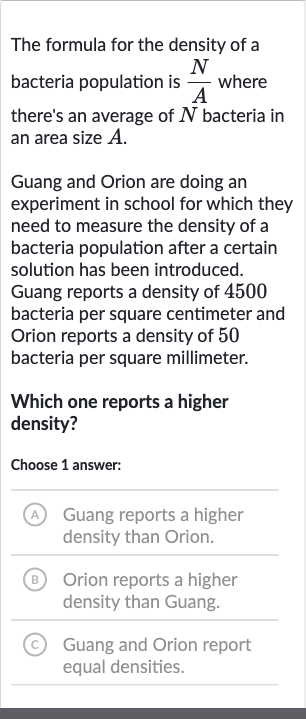AI tutor
Welcome to Bytelearn!
Let’s check out your problem:

The formula for the density of a bacteria population is where there's an average of bacteria in an area size . Guang and Orion are doing an experiment in school for which they need to measure the density of a bacteria population after a certain solution has been introduced. Guang reports a density of bacteria per square centimeter and Orion reports a density of bacteria per square millimeter. Which one reports a higher density? Choose answer:(A) Guang reports a higher density than Orion.(B) Orion reports a higher density than Guang.(C) Guang and Orion report equal densities.
Full solution
Q. The formula for the density of a bacteria population is where there's an average of bacteria in an area size . Guang and Orion are doing an experiment in school for which they need to measure the density of a bacteria population after a certain solution has been introduced. Guang reports a density of bacteria per square centimeter and Orion reports a density of bacteria per square millimeter. Which one reports a higher density? Choose answer:(A) Guang reports a higher density than Orion.(B) Orion reports a higher density than Guang.(C) Guang and Orion report equal densities.
- Understand units: Understand the units used by Guang and Orion.Guang reports a density in bacteria per square centimeter, while Orion reports a density in bacteria per square millimeter. To compare their reported densities, we need to convert them to the same units.
- Convert Orion's density: Convert Orion's density to bacteria per square centimeter.There are millimeters in a centimeter, so there are square millimeters in a square centimeter. Therefore, to convert Orion's density to the same units as Guang's, we multiply by .Orion's density in bacteria per square centimeter = bacteria/mm² mm²/cm² = bacteria/cm².
- Compare densities: Compare the densities reported by Guang and Orion.Guang reports a density of bacteria/, and Orion reports a density of bacteria/ after converting to the same units.
- Determine higher density: Determine who reports a higher density.Since bacteria/cm (Orion's density) is greater than bacteria/cm (Guang's density), Orion reports a higher density than Guang.
More problems from Multi-step problems with unit conversions
QuestionGet tutor help
QuestionGet tutor help
QuestionGet tutor help
QuestionGet tutor help
QuestionGet tutor help
